The Inorganic filler Market is estimated to be valued at USD 81.8 billion in 2025 and is projected to reach USD 127.0 billion by 2035, registering a compound annual growth rate (CAGR) of 4.5% over the forecast period.
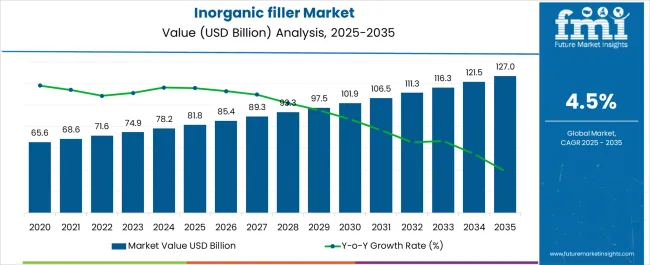
| Metric | Value |
|---|---|
| Inorganic filler Market Estimated Value in (2025 E) | USD 81.8 billion |
| Inorganic filler Market Forecast Value in (2035 F) | USD 127.0 billion |
| Forecast CAGR (2025 to 2035) | 4.5% |
The Inorganic Filler market is witnessing steady growth, driven by the rising demand for enhanced material properties in end-use industries such as paper, plastics, paints, coatings, and adhesives. Fillers are increasingly being adopted to improve product strength, opacity, whiteness, and processability while reducing production costs.
The market is supported by ongoing innovations in material processing and surface modification techniques that improve filler compatibility and performance in diverse applications. Environmental regulations and sustainability initiatives are also influencing growth, as inorganic fillers such as calcium carbonates reduce reliance on synthetic or resource-intensive materials.
Growing demand for high-quality paper and packaging products, along with expanding industrial and construction activities globally, further supports market expansion As manufacturers focus on improving operational efficiency and product functionality, the Inorganic Filler market is expected to experience long-term growth, with developments in filler technology, enhanced application performance, and cost optimization driving adoption across multiple sectors.
The inorganic filler market is segmented by product category, application, and geographic regions. By product category, inorganic filler market is divided into Calcium Carbonates, Silica, Kaolin, Talc, Calcium Sulfate, Alumina Trihydrate (ATH), and Others. In terms of application, inorganic filler market is classified into Paper, Thermoplastics And Thermosets, Paints & Coatings, Rubber, Adhesives And Sealants, and Others. Regionally, the inorganic filler industry is classified into North America, Latin America, Western Europe, Eastern Europe, Balkan & Baltic Countries, Russia & Belarus, Central Asia, East Asia, South Asia & Pacific, and the Middle East & Africa.
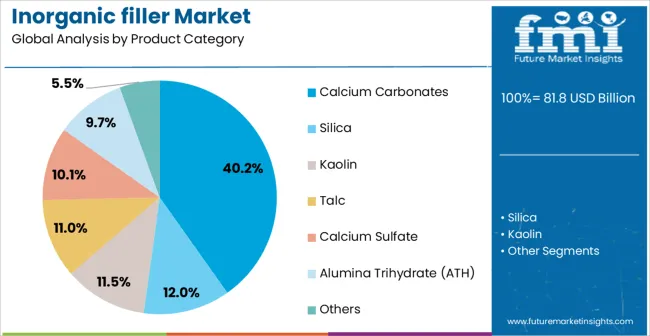
The calcium carbonates product category is projected to hold 40.2% of the Inorganic Filler market revenue in 2025, making it the leading product type. Its dominance is driven by its high availability, cost-effectiveness, and ability to enhance material properties such as whiteness, opacity, and surface smoothness. Calcium carbonates are widely used in applications requiring improved printability, durability, and mechanical performance, particularly in paper, plastics, and paints.
Their surface-modified variants allow better dispersion and compatibility with diverse polymer and coating systems. The ability to reduce production costs while maintaining or enhancing product quality has strengthened its adoption in industrial applications.
Additionally, environmental sustainability considerations, such as reduced energy consumption in paper production, have reinforced preference for calcium carbonates As manufacturers continue to focus on efficiency, performance, and regulatory compliance, the calcium carbonates segment is expected to maintain its leading position in the Inorganic Filler market, supported by technological innovation and widespread industrial utilization.
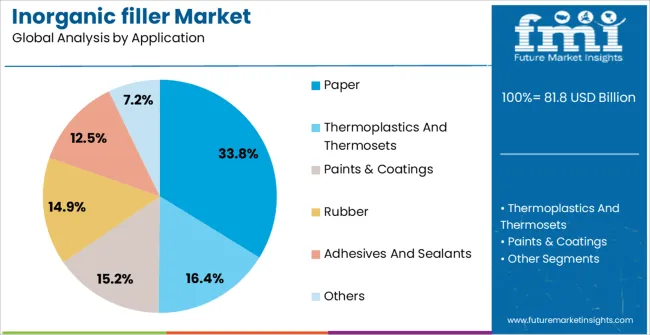
The paper application segment is anticipated to account for 33.8% of the Inorganic Filler market revenue in 2025, establishing it as the leading application area. Its growth is being driven by the need for high-quality printing paper, packaging materials, and specialty paper with enhanced whiteness, opacity, smoothness, and printability. Inorganic fillers, particularly calcium carbonates, are incorporated to improve surface finish, bulk, and mechanical strength while reducing raw material costs.
The increasing demand for sustainable and recyclable paper products is further reinforcing the adoption of fillers in this sector. Manufacturing processes benefit from the ability to optimize filler content without compromising paper quality, enabling operational efficiency and cost savings.
As digital and print media coexist, demand for premium printing and packaging paper continues to rise, supporting sustained growth of this application segment The adoption of advanced filler technologies and surface-treated products is expected to further enhance performance and maintain the leadership of the paper segment within the Inorganic Filler market.
Inorganic fillers are defined as resin particles, designed to provide strength to the composite minimize polymerization, decrease thermal expansion, and reduce amount of swelling which is caused due to the water desorption. There are many factors which affect the function of fillers some of them are Filler shape, Refractive index etc.
With the help of inorganic fillers properties of composites are enhanced which is considered to be one the major driver for the growth of Inorganic filler market. Higher the filler content the stronger the material. Particle size also affects the polish ability and wear resistance ability of a material.
Smaller filler particles cannot be easily pulled from the resin thus produce fewer voids and restrict wear. Coupling are used or the surface treatment of inorganic fillers. When inorganic fillers is used in epoxy resin it reduces the friction and increase the wear resistance.
Alumina Trihydrate (ATH) and silica which are inorganic fillers help to improve the erosion resistance of silicon rubber. Research is also going on for using inorganic fillers for dental application to improve the interfacial properties.
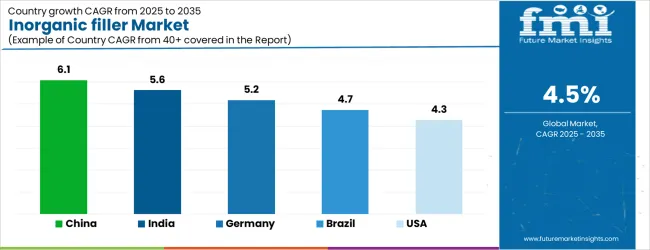
| Country | CAGR |
|---|---|
| China | 6.1% |
| India | 5.6% |
| Germany | 5.2% |
| Brazil | 4.7% |
| USA | 4.3% |
| UK | 3.8% |
| Japan | 3.4% |
The Inorganic filler Market is expected to register a CAGR of 4.5% during the forecast period, exhibiting varied country level momentum. China leads with the highest CAGR of 6.1%, followed by India at 5.6%. Developed markets such as Germany, France, and the UK continue to expand steadily, while the USA is likely to grow at consistent rates. Japan posts the lowest CAGR at 3.4%, yet still underscores a broadly positive trajectory for the global Inorganic filler Market. In 2024, Germany held a dominant revenue in the Western Europe market and is expected to grow with a CAGR of 5.2%. The USA Inorganic filler Market is estimated to be valued at USD 29.0 billion in 2025 and is anticipated to reach a valuation of USD 29.0 billion by 2035. Sales are projected to rise at a CAGR of 0.0% over the forecast period between 2025 and 2035. While Japan and South Korea markets are estimated to be valued at USD 3.7 billion and USD 2.7 billion respectively in 2025.
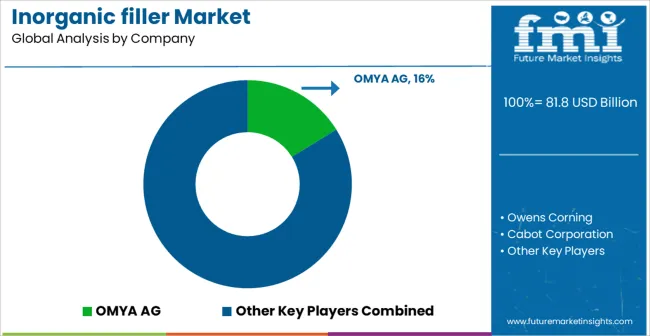
| Item | Value |
|---|---|
| Quantitative Units | USD 81.8 Billion |
| Product Category | Calcium Carbonates, Silica, Kaolin, Talc, Calcium Sulfate, Alumina Trihydrate (ATH), and Others |
| Application | Paper, Thermoplastics And Thermosets, Paints & Coatings, Rubber, Adhesives And Sealants, and Others |
| Regions Covered | North America, Europe, Asia-Pacific, Latin America, Middle East & Africa |
| Country Covered | United States, Canada, Germany, France, United Kingdom, China, Japan, India, Brazil, South Africa |
| Key Companies Profiled | OMYA AG, Owens Corning, Cabot Corporation, Imerys, Albemarle Corporation, Nippon Chemical Industrial, CHALCO Shandong Advanced Material, Marubeni Europe, Novista Group, KISCO Ltd., and Harmony Additive Pvt. Ltd |
The global inorganic filler market is estimated to be valued at USD 81.8 billion in 2025.
The market size for the inorganic filler market is projected to reach USD 127.0 billion by 2035.
The inorganic filler market is expected to grow at a 4.5% CAGR between 2025 and 2035.
The key product types in inorganic filler market are calcium carbonates, silica, kaolin, talc, calcium sulfate, alumina trihydrate (ath) and others.
In terms of application, paper segment to command 33.8% share in the inorganic filler market in 2025.






Our Research Products

The "Full Research Suite" delivers actionable market intel, deep dives on markets or technologies, so clients act faster, cut risk, and unlock growth.

The Leaderboard benchmarks and ranks top vendors, classifying them as Established Leaders, Leading Challengers, or Disruptors & Challengers.

Locates where complements amplify value and substitutes erode it, forecasting net impact by horizon

We deliver granular, decision-grade intel: market sizing, 5-year forecasts, pricing, adoption, usage, revenue, and operational KPIs—plus competitor tracking, regulation, and value chains—across 60 countries broadly.

Spot the shifts before they hit your P&L. We track inflection points, adoption curves, pricing moves, and ecosystem plays to show where demand is heading, why it is changing, and what to do next across high-growth markets and disruptive tech

Real-time reads of user behavior. We track shifting priorities, perceptions of today’s and next-gen services, and provider experience, then pace how fast tech moves from trial to adoption, blending buyer, consumer, and channel inputs with social signals (#WhySwitch, #UX).

Partner with our analyst team to build a custom report designed around your business priorities. From analysing market trends to assessing competitors or crafting bespoke datasets, we tailor insights to your needs.
Supplier Intelligence
Discovery & Profiling
Capacity & Footprint
Performance & Risk
Compliance & Governance
Commercial Readiness
Who Supplies Whom
Scorecards & Shortlists
Playbooks & Docs
Category Intelligence
Definition & Scope
Demand & Use Cases
Cost Drivers
Market Structure
Supply Chain Map
Trade & Policy
Operating Norms
Deliverables
Buyer Intelligence
Account Basics
Spend & Scope
Procurement Model
Vendor Requirements
Terms & Policies
Entry Strategy
Pain Points & Triggers
Outputs
Pricing Analysis
Benchmarks
Trends
Should-Cost
Indexation
Landed Cost
Commercial Terms
Deliverables
Brand Analysis
Positioning & Value Prop
Share & Presence
Customer Evidence
Go-to-Market
Digital & Reputation
Compliance & Trust
KPIs & Gaps
Outputs
Full Research Suite comprises of:
Market outlook & trends analysis
Interviews & case studies
Strategic recommendations
Vendor profiles & capabilities analysis
5-year forecasts
8 regions and 60+ country-level data splits
Market segment data splits
12 months of continuous data updates
DELIVERED AS:
PDF EXCEL ONLINE
Inorganic Cobalt Blue Pigments Market Size and Share Forecast Outlook 2025 to 2035
Filler and Extender Cosmetics Market Analysis - Size and Share Forecast Outlook 2025 to 2035
Inorganic Scintillators Market Size and Share Forecast Outlook 2025 to 2035
Fillers & Extenders Market Size and Share Forecast Outlook 2025 to 2035
Inorganic Oxides Market Size and Share Forecast Outlook 2025 to 2035
Inorganic Salts Market Size and Share Forecast Outlook 2025 to 2035
Inorganic Zinc Coatings Market Size and Share Forecast Outlook 2025 to 2035
Inorganic Fungicide Market - Growth & Demand 2025 to 2035
Industry Share Analysis for Inorganic Scintillators Companies
Inorganic Flame Retardants Market
Inorganic Ion Exchange Materials Market
Lip Filler Market Analysis Size and Share Forecast Outlook 2025 to 2035
Cup Filler Market
Sack Fillers Market Size and Share Forecast Outlook 2025 to 2035
White Inorganic Pigment Market Size and Share Forecast Outlook 2025 to 2035
Pouch Filler Market Analysis - Size, Share, & Forecast Outlook 2025 to 2035
Auger Filler Market Growth - Trends & Forecast 2025 to 2035
Global Wound Filler Market Analysis – Size, Share & Forecast 2024-2034
Paper Filler Market Trends & Industry Growth Forecast 2024-2034
Dermal Fillers Market Analysis - Size, Share, and Forecast Outlook 2025 to 2035

Thank you!
You will receive an email from our Business Development Manager. Please be sure to check your SPAM/JUNK folder too.
Chat With
MaRIA